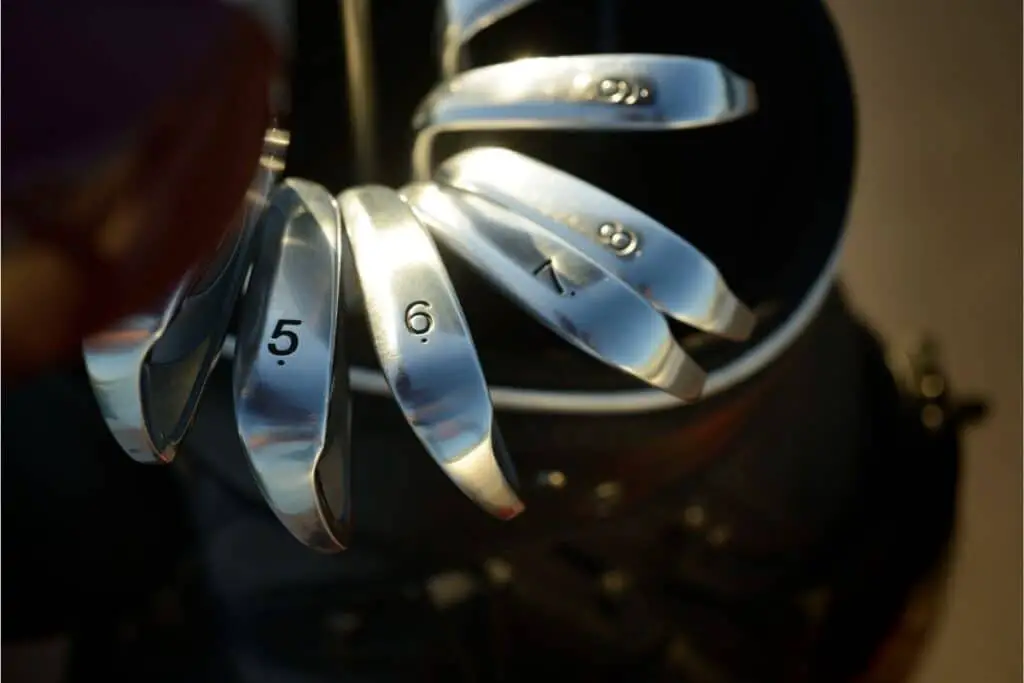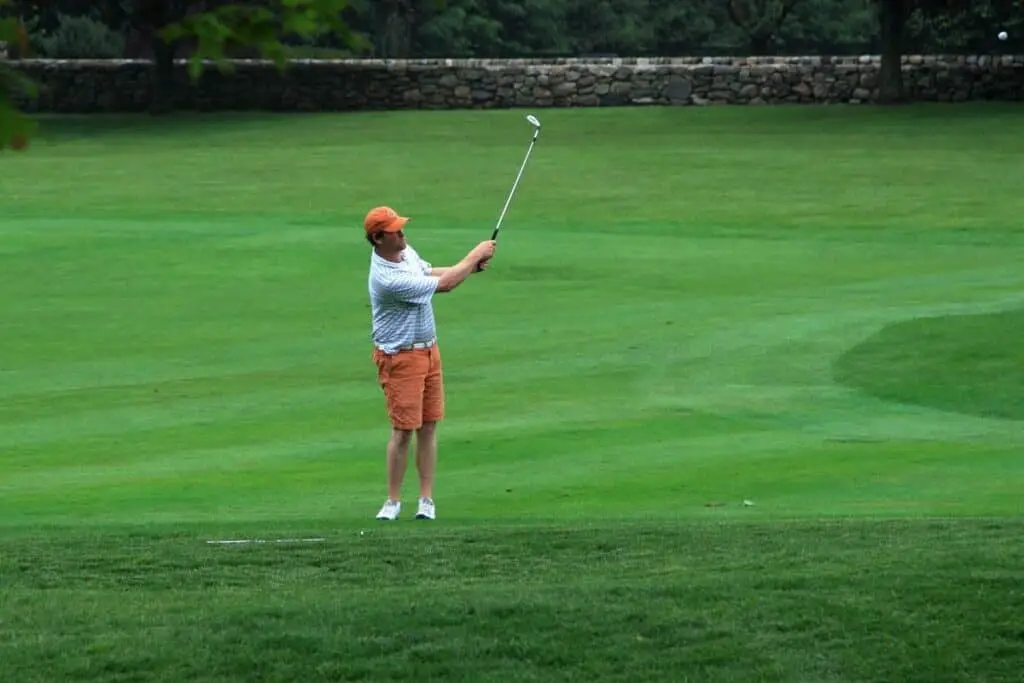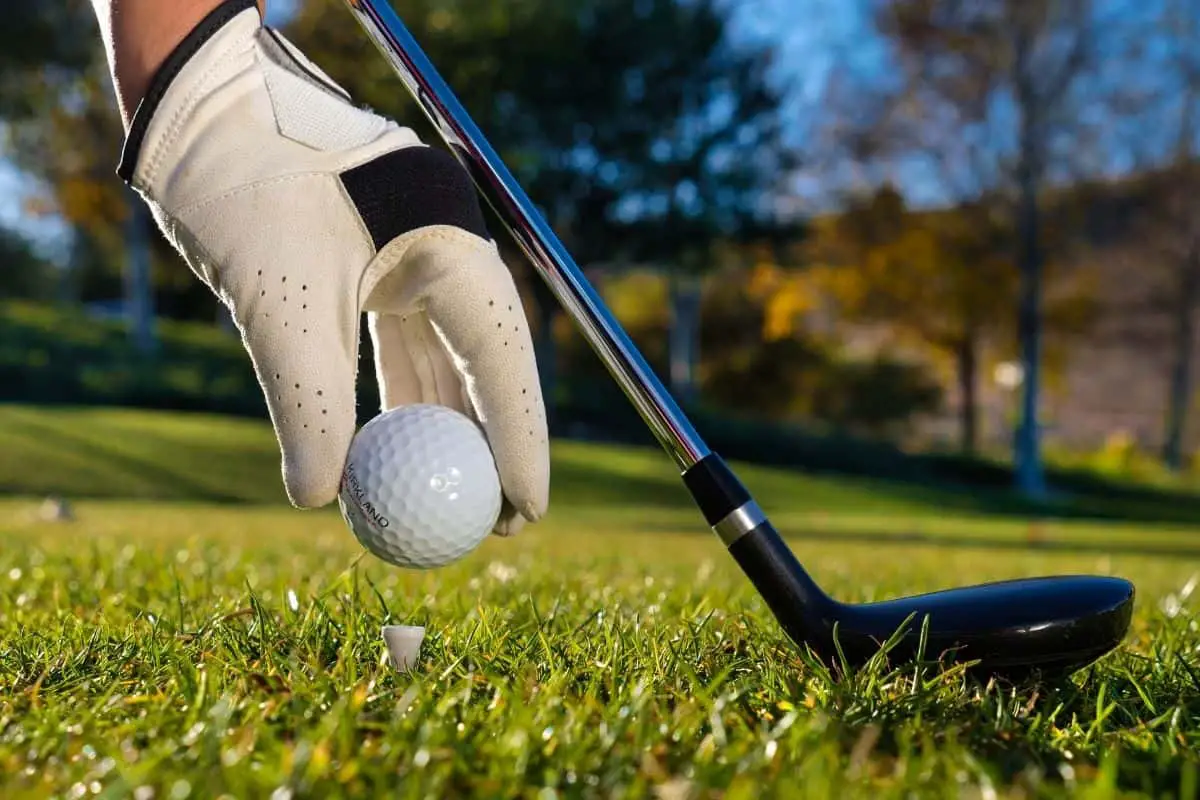The average distance for different types of golf clubs will vary depending on who is using the club. If the player is more skilled or more powerful then they will be able to achieve a greater distance with the club.
We have put together the average distances for various types of people using the different golf clubs, along with some information about the clubs and how to achieve good distance.
Keep reading to find out more.
Types Of Golf Clubs

Before we delve into the average distances of the different clubs, you must understand the difference between woods, irons, and wedges.
What Is A ‘Wood’ Golf Club?
A wood is one of three main types of golf clubs used in the game of golf. They are generally longer than an iron, but shorter than a driver. Wood clubs are designed to hit the ball longer distances than other types of golf clubs.
Woods are usually made from persimmon, maple, ash, hickory, and bamboo. Several woods are specifically designed for use by women.
What Is An ‘Iron’ Golf Club?
Iron is another type of golf club used in golf. It is very similar to a wood in terms of length and shape.
However, it has a larger head which makes it easier to swing. Irons are typically made from steel, titanium, graphite, and stainless steel.
Some irons are designed to help you get better control over your shots. These include adjustable irons, cavity back irons, and hybrid irons.
What Is A ‘Wedge’ Golf Club?
The wedge is a third type of golf club used when playing golf. Wedges are designed to help players hit the ball straighter into the hole.
Wedge designs can come in many shapes and sizes. For example, there are full-shafted wedges, half-shafted wedges, and even hybrids.
Most wedges have a blade attached to the end of the club. This helps the player make contact with the ball at the right point as well as increase the power behind their swings.
When choosing a wedge design, consider what kind of shot you want to play.
How Is Distance Achieved?

Different elements can have a big impact on the distance achieved with the golf club. We are going to take a look at these in a bit more detail to help you understand all of the factors that come together to create a distance shot.
Loft
Loft refers to the angle of the face of the club. Generally, the loft increases with the number of degrees the face of the club is angled up.
In general, the higher the loft, the farther the ball travels. You should always aim to keep the loft of your golf club within 3 degrees of the ideal loft for your particular style of play.
Stiffness
Stiffness refers to the overall stiffness of the shaft of the club. This means that the club is stiffer or less flexible than other clubs. Flexibility is measured by the amount of deflection the shaft experiences during the swing.
The higher the flexibility, the lower the deflection. Typically, if the shaft bends too much, this results in poor accuracy.
Weight
Weight refers to how heavy the club feels. If the weight of the club feels light, then it will be harder to swing.
Conversely, if the weight feels heavy, it will feel easier to swing. The heavier the club, the further the ball will travel.
Length
The length refers to the total length of the club. Longer clubs tend to provide greater forgiveness and allow for more powerful shots. Shorter clubs are preferred for shots where accuracy is key.
Weather
The weather can have a big impact on how far the ball travels. The strength and direction of the wind can interfere with your shot, but heavy rain can also make it more challenging to achieve a good distance.
Swing Speed
Swing speed and distance are directly linked to each other. The faster your swing, the more power there will be behind the ball. This makes the ball travel faster.
This is why having strong muscles does not necessarily mean that you will hit the ball further, you need to be able to move your body quickly to generate power.
Some female golf professionals can achieve greater distances than men for this reason.
More About Loft Angles
As we mentioned earlier, the loft of the club has a direct impact on the distance you can achieve. Let’s have a look at this in more detail.
Drivers
Drivers tend to be used when you want to achieve maximum distance, carrying the ball as far as possible.
The loft angle will vary between manufacturers and models, but it tends to be between 8 and 13 degrees.
Woods
Woods come in four types – 2 wood, 3 wood, 4 wood, and 5 wood. These clubs are also used to achieve distance, but also height. This means that they are more tangled than a driver which allows you to get the ball over obstacles.
2 woods tend to be between 12 and 15 degrees, 3 woods between 12 and 17 degrees, 4 woods between 15 and 19 degrees, and 5 woods between 20 and 23 degrees.
Irons
You tend to use an iron on the green. The height that the ball reaches is used to more accurately control the distance that the ball travels, allowing you to get closer to the hole and avoid tricky parts of the green. There are 9 different types of iron with varying loft angles:
- 1 Iron – 15-18 degrees
- 2 Iron – 18-20 degrees
- 3 Iron – 21-24 degrees
- 4 Iron – 25-28 degrees
- 5 Iron – 28-32 degrees
- 6 Iron – 32-36 degrees
- 7 Iron – 36-40 degrees
- 8 Iron – 40-44 degrees
- 9 Iron – 45-48 degrees
Wedges
Finally, we have wedges. They are used predominantly to achieve height on the ball so they are the most angled of all of the clubs. A pitching wedge tends to have a loft angle of 41 to 46 degrees.
A gap wedge is between 48 and 52 degrees. A sand wedge is between 54 and 56 degrees. A lob wedge is between 58 and 60 degrees.
Average Distances For Different Clubs Depending On The Player

Average Distances For Men
Now let’s take a look at the average figures for the distance that men can achieve with the different clubs:
- Driver – 200 yards for a short hitter, 230 yards for a mid hitter, and 260 yards for a long hitter
- 3 Wood – 180 yards for a short hitter, 215 yards for a mid hitter, and 235 yards for a long hitter
- 5 Wood – 170 yards for a short hitter, 195 yards for a mid hitter 210 yards for a long hitter
- 3 Hybrid – 163 yards for a short hitter, 190 yards for a mid hitter, and 205 yards for a long hitter
- 3 Iron – 160 yards for a short hitter, 180 yards for a mid hitter, and 200 yards for a long hitter
- 4 Iron – 150 yards for a short hitter, 170 yards for a mid hitter, and 180 yards for a long hitter
- 5 Iron – 140 yards for a short hitter, 160 yards for a mid hitter, and 170 for a long hitter
- 6 Iron – 130 yards for a short hitter, 150 yards for a mid hitter, and 160 yards for a long hitter
- 7 Iron – 120 yards for a short hitter, 140 yards for a mid hitter, and 150 yards for a long hitter
- 8 Iron – 110 yards for a short hitter, 130 yards for a mid hitter, and 140 yards for a long hitter
- 9 Iron – 95 yards for a short hitter, 115 yards for a mid hitter, and 130 for a long hitter
- Pitching Wedge – 80 yards for a short hitter, 105 yards for a mid hitter, and 120 for a long hitter
- Sand Wedge – 60 yards for a short hitter, 80 yards for a mid hitter, and 100 yards for a long hitter
- Lob Wedge – 50 yards for a short hitter, 70 yards for a mid hitter, and 90 yards for a long hitter
Average Distances For Women
Here are the average figures for the distance that female players can achieve with the different clubs:
- Driver – 150 yards for a short hitter, 175 yards for a mid hitter, and 200 yards for a long hitter
- 3 Wood – 125 yards for a short hitter, 150 yards for a mid hitter, and 180 yards for a long hitter
- 5 Wood – 115 yards for a short hitter, 135 yards for a mid hitter 170 yards for a long hitter
- 3 Hybrid – 105 yards for a short hitter, 130 yards for a mid hitter, and 165 yards for a long hitter
- 3 Iron – 100 yards for a short hitter, 125 yards for a mid hitter, and 160 yards for a long hitter
- 4 Iron – 90 yards for a short hitter, 120 yards for a mid hitter, and 150 yards for a long hitter
- 5 Iron – 80 yards for a short hitter, 110 yards for a mid hitter, and 140 for a long hitter
- 6 Iron – 70 yards for a short hitter, 100 yards for a mid hitter, and 130 yards for a long hitter
- 7 Iron – 65 yards for a short hitter, 90 yards for a mid hitter, and 120 yards for a long hitter
- 8 Iron – 60 yards for a short hitter, 80 yards for a mid hitter, and 110 yards for a long hitter
- 9 Iron – 55 yards for a short hitter, 70 yards for a mid hitter, and 95 for a long hitter
- Pitching Wedge – 50 yards for a short hitter, 60 yards for a mid hitter, and 80 for a long hitter
- Sand Wedge – 40 yards for a short hitter, 50 yards for a mid hitter, and 60 yards for a long hitter
- Lob Wedge – 35 yards for a short hitter, 45 yards for a mid hitter, and 50 yards for a long hitter
Average Distances For Senior Tour Players
These are the average distances that senior tour players can achieve with the different clubs:
- Driver – 274-284 yards
- 3 Wood – 230-239 yards
- 5 Wood – 218-226 yards
- 3 Iron – 201-208 yards
- 4 Iron – 192-199 yards
- 5 Iron – 184-191 yards
- 6 Iron – 173-180 yards
- 7 Iron – 163-169 yards
- 8 Iron – 151-157 yards
- 9 Iron – 140-145 yards
- Pitching Wedge – 129-134 yards
Average Distances for PGA Tour Players
Here are the average distances that PGA tour players can reach with the different clubs:
- Driver – 289-323 yards
- 3 Wood – 243-304 yards
- 5 Wood – 230-288 yards
- 3 Iron – 212-265 yards
- 4 Iron – 203-254 yards
- 5 Iron – 184-191 yards
- 6 Iron – 194-243 yards
- 7 Iron – 172-215 yards
- 8 Iron – 160-200 yards
- 9 Iron – 148-185 yards
- Pitching Wedge – 136-170 yards
Average Distance For LPGA Tour Players
Finally, we have the average distances reached by the LPGA tour players using the different clubs:
- Driver – 246-258 yards
- 3 Wood – 195-217 yards
- 5 Wood – 185-205 yards
- 4 Iron – 170-181 yards
- 5 Iron – 161-173 yards
- 6 Iron – 152-163 yards
- 7 Iron – 141-154 yards
- 8 Iron – 130-143 yards
- 9 Iron – 119-132 yards
- Pitching Wedge – 107-121 yards
Why Is It Important To Track Your Distance?
There are lots of elements that make up a successful golfer. Form is important- practicing your swing and your putting. But people often underestimate the importance of choosing the right club for the shot that you want to play.
You need to be able to assess the situation – the direction of the wind, the gradient of the ground, the distance you need the ball to travel, how much you want the ball to roll on after it has landed, any obstacles that are in the way.
Once you have considered all of these factors, you then need to choose the club that is going to give you the best chance of hitting the perfect shot.
If you track your distances with the various clubs in your set, then you will have a much better idea of what your averages are.
This will help you to choose the right club while you are in the middle of a game, as you will know what distance you are likely to achieve.
Summary
The distance that you can reach with the different golf clubs varies greatly depending on several factors. The weather can play a big part in determining how far the ball will travel, especially if it is a particularly windy day.
The design of the club affects the distance of the ball, such as the weight and the shaft type.
The loft angle makes a big difference to the distance of the ball. There is a delicate balance between height helping the ball to go further, or too much loft reducing the distance of the ball.
Perhaps the most significant factor is the skill of the player. Swing speed and form will drastically change the distance of the ball.
- Should Tee Boxes Be Level? - January 23, 2024
- 3 Hybrid Distance - November 15, 2023
- Innovations in Golf Mobility: An In-depth Review of Top Golf Scooters - October 12, 2023
